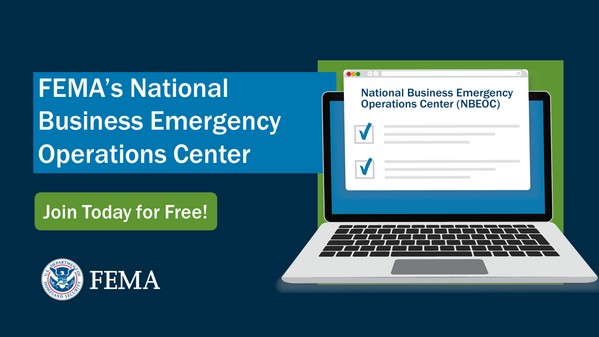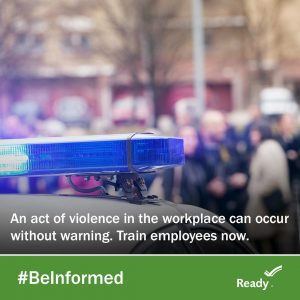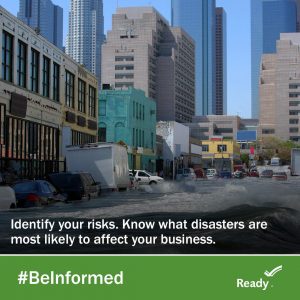Small business owners feel very knowledgeable about:
%
Disaster Preparedness
%
Cybersecurity risk management
Join FEMA’s National Business Emergency Center
Today, businesses may face increasing risks from natural disasters, cybersecurity threats and other disruptive emergencies. FEMA’s National Business Emergency Operations Center helps business and industry leaders to stay informed, collaborate with emergency management officials and access resources for potential disasters and response efforts.
The National Business Emergency Operations Center is a virtual platform that connects businesses and industry partners with FEMA and other response agencies during disasters. Membership is open to organizations of all sizes and across all industries – providing near real-time situational awareness and coordination before, during and after emergencies.
By becoming a National Business Emergency Operations Center member, emergency managers and business leaders can:

- Gain Early Access to Critical Information – Receive near real-time updates on disaster response efforts and potential impacts on supply chains, infrastructure and operations.
- Collaborate Directly with FEMA and Partners – Engage with government agencies and industry peers to discuss disaster preparedness, response and recovery efforts.
- Support Business Continuity – Stay informed about resources, tools and educational programs that help businesses prepare for and recover more quickly after disasters.
- Inform Emergency Management Decisions – Share industry insights with FEMA to help shape response strategies that benefit businesses and the communities they serve.
Follow the steps below to join:
- Visit the National Business Emergency Operations Center Website – Visit National Business Emergency Operations Center | FEMA.gov.
- Submit the Membership Form – Fill out a short form with your organization’s details. Please note that the National Business Emergency Operations Center membership requires a business email domain.
- Stay Connected – Once approved, members can access the National Business Emergency Operations Center Dashboard 24/7 for updates, receive invitations to briefings and have opportunities to participate in disaster coordination efforts.
Please reach out to FEMA’s Office of Business, Industry and Infrastructure Integration team at NBEOC@connect.gov with questions or feedback.
 |
 |
 |
Business preparedness is crucial for minimizing losses and maximizing recovery speed in the face of emergencies, from natural disasters to cyberattacks. It helps businesses to be able to retain employees, attract new ones, and rebuild trust with customers, ultimately impacting long-term success and the local economy.
Here’s a more detailed breakdown of why business preparedness is important:
-
Reduced Costs: Prepared businesses can mitigate the impact of damage and disruption, leading to lower costs for repairs, temporary relocation, and lost revenue.
-
Faster Recovery: A well-defined plan allows businesses to resume operations sooner after an event, minimizing disruption and maintaining a steady income stream.
-
Reduced Risk of Permanent Closure: Being prepared significantly increases the likelihood of surviving a disaster and reopening, compared to businesses that are unprepared.
-
Access to Financial Aid: Prepared businesses are better positioned to access government assistance programs, such as disaster loans, in the event of an emergency.
-
Employee Safety: Preparedness plans include protocols for evacuation, communication, and supporting employees’ well-being during and after an emergency, ensuring their safety and reducing anxiety.
-
Customer Loyalty: Businesses that demonstrate resilience and a commitment to serving customers during difficult times build trust and loyalty, strengthening their customer base.
-
Public Reputation: Publicly demonstrating preparedness and a swift recovery from a crisis can improve a company’s image and brand recognition.
-
Resilience: Prepared businesses contribute to the overall resilience of their community, helping to rebuild after a disaster and maintain economic stability.
-
Economic Benefits: Businesses that can resume operations quickly after an event help to restore economic activity, creating jobs and supporting local suppliers.
-
Community Trust: Businesses that prioritize preparedness demonstrate a commitment to the community, fostering trust and goodwill.
-
Preventing Further Losses: Preparedness measures, such as fireproofing, earthquake-resistant construction, and flood control, can help prevent or minimize the impact of disasters.
-
Reducing Emotional Toll: Having a plan in place can reduce fear, anxiety, and stress for both employees and owners during and after an emergency.
-
Building a Culture of Preparedness: Integrating preparedness into a company’s culture encourages a proactive approach to risk management and fosters a sense of responsibility and teamwork.
Per the U.S. Department of Homeland Security (DHS) – Businesses can do much to prepare for the impact of the many hazards they face in today’s world including natural hazards, human-caused hazards or technology related hazards. DHS has provided the following list of hazards.
-
-
- Natural hazards could be a flood, hurricane, tornado, earthquake or a widespread serious illness such as the H1N1 flu virus pandemic or COVID.
- Human-caused hazards include accidents, acts of violence by people and acts of terrorism.
- Examples of technology-related hazards are the failure or malfunction of systems, equipment or software.
-
To minimize the impact of those listed hazards/disasters on employees, property, and operations, businesses must make the right preparations. These include: creating a disaster plan, identifying priorities, training employees on emergency preparedness, and reviewing the business’ insurance coverage. Below are the “Top 10 Preparedness Tips” according to the U.S. Chamber of Commerce.
-
- Organize a staff team to create your plan.
- Gather critical documents and information needed for decision making.
- Identify and prioritize the company’s most important operations and processes.
- Identify hazards and potential disruptions to your operations.
- Keep it simple: design a plan that is easy to understand and implement.
- Create a communications strategy and plan to use it post emergency. Maintain an up-to-date emergency contact list for employees, vendors, suppliers, and other key stakeholders.
- Recruit and train employee volunteers that can effectively manage the response.
- Back up and store vital records and data at an off-site location.
- Take action to mitigate the potential impact of a disaster on equipment, buildings, facilities, inventory, and storage. Consider your insurance options and whether to purchase a generator.
- Exercise, test, and update your plan at least annually.
Utilize the checklists offered below to begin constructing your preparedness plan/activities.
Below are a few toolkits and self assessment documents (created by Ready.gov) you can use to test your current plans (if in place) or help to create a stronger emergency plan.
Follow the links below to learn more about business disaster/emergency planning and recovery.